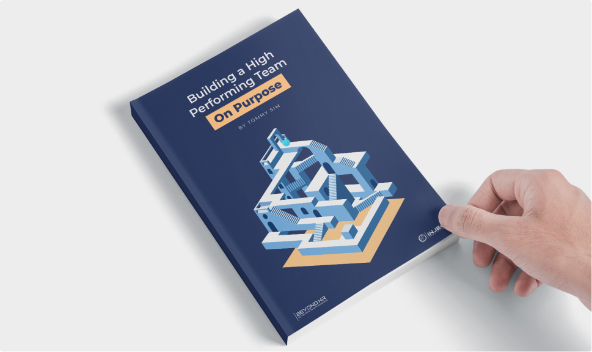This is Chapter 1 in the 8 part self-guided series, Building A High Performing Team On Purpose.
As we emerge squinty-eyed from the cocoons that were our WFH stations, the question on a lot of minds now is when can we go back to normal? For many business owners, the end to the COVID-19 crisis cannot come soon enough. The stress, financial pressure and workload have been enormous and in a lot of cases without the financial return. It would be understandable if business owners just wanted to go back to how things were as fast as possible, pretending the crisis were over and it was business as usual.
There is no normal though. There may be a new normal coming up, but we don’t quite know what that is yet.
The return to work is a “moment of truth” for your employees.
A moment of truth is a point in the customer journey that has the potential for heightened emotions, whether those are positive or negative. The employees who work in your business also happen to be people (for the time being). So, as employees they also have moments of truth that have a heightened emotional potential. Returning to work amid a global pandemic due to a silently contagious virus that has killed hundreds of thousands of people might just be one of those situations. How you handle the return to work will be remembered by your staff. This entire period we are in will be studied for decades and perhaps centuries. Your kids and grandchildren will ask you what it was like.
She’ll be right mate.
Possibly. But maybe she won’t and that’s when the steps you took to look after your team will come under the microscope. More than that, it’s how your team perceives your approach and what message this sends to them about their value. This is not just about them; it is about their colleagues and their colleague’s families. Especially in times like these, words mean less than actions.
You cannot build a high performing team if your team doesn’t trust you or think you are looking out for their well-being. If they don’t think you have their best interests at heart, then when you need their help to outperform the competition, they may be a little less present – or not present at all. It is worthwhile putting in the effort to have the right plan for returning.
There are three leadership challenges from COVID-19 coming up that I liken to the Three Bears. There is what seems like a little challenge, which is to get everyone back to work. But we all know that if we get bitten by a little bear it still hurts. We have a medium-sized challenge, which is how can we find the most productive way to work ongoing now that we have had a taste of working from home en masse. Finally, this situation creates an opportunity to look at your business in a completely different way than we have never seen before — the big, grizzly bear.
The Little Bears
We have two lifts in our building and to adhere to the 1.5m rule, only two people are allowed per lift. With four levels and 25 people per floor, if everyone arrived at 8.30am it would be chaos. Fortunately, taking the stairs is an option. But what if you were in a skyscraper and on the 30th floor?
This is just one, small problem that you will face with having your team return to the office.
This transition period ahead of you is an opportunity to demonstrate to your people what type of leader you are. It is a time where there can be significant apprehension and it is easy to show no empathy if we don’t have the same concerns. Empathy is an important part of being a good leader and so each business leader is on center stage right now, whether we like it or not.
To keep things simple, from a practical level, think through the following questions:
- What is our plan for returning?
- How do we make our workplace safe in the circumstances?
- When, how and whom should we consult with?
- In addition to physical health, what is our approach to supporting the mental health of our people?
To help you with this process, I have fleshed each one out a bit more below.
Little Bear #1: What is our plan for returning?
Every workplace is different, and every employee is different. So, you need a plan that factors in these differences before they become issues for you.
Think through the steps that your employees will take to return.
- What are the potential issues?
- What might be the concerns of each employee and/or group?
Rather than just listing “employees”, consider each person and/or group. Look at it through multiple lenses. It’s not just finance or sales. It’s parents, non-parents, those who look after an elderly parent, those with anxiety and those who have had their head in the sand this whole time. Once you sort all the different groups, you can then start to flesh out what to do.
Consider even just one topic around the lifts. To avoid the lift chaos described above, you could consider different start and finish times where you can. On top of the lift fiasco, there will be an increased number of cars on the roads due to people avoiding public transport. You could also consider bringing people partially back a few days a week as this could mitigate issues because people aren’t at the workplace as much.
What about different shifts? If there is one person who is tested as positive, you reduce the likelihood of infection to fewer people.
Little Bear #2: How do we make our workplace safe in the circumstances?
Making the workplace safe is so often one of those statements that is hard to refute (who wouldn’t want a safe workplace?) but doesn’t always follow in practice. It’s like how people who smoke don’t actually think it’s good for you. They just haven’t prioritised quitting or else don’t care about their health. My message to you is to do something and access the resources available. Get some people around a virtual table and talk through what might be some of the risks or challenges.
To get you started, below are some thought starters. You should do what works for your business and people.
- What is our approach to hygiene based on surfaces (e.g. doorknobs) and people (e.g. hand sanitizer)?
- How does the 1.5m rule impact our current desk spacing?
- How do we keep good hygiene top of mind for people without eyes rolling?
- How do we manage people who may have symptoms, both reportedly when absent and if someone were to show up with symptoms?
What about when working offsite? Think about the following:
- How do they deal with practices at a customer’s site that is not the same as your office?
- How do they deal with the handshake?
- What if too many people get into the lift?
Little Bear #3: When, how and who should we consult with?
As a business leader, you might often feel like the weight of the world is on your shoulders. People are coming to you for answers. It might seem logical to think you need to have all the answers – you don’t. Go to your team with your initial thoughts earlier than what you feel comfortable with. This means your plan won’t be perfect and it can allow others to fill in the blanks. Not only it is a legal requirement to consult with your staff on health and safety matters, but it will also help them feel part of it as well.
Consider the following:
- Who in my business is vulnerable due to their age, pre-existing illness or other factors?
- Do I know my team well enough to ascertain who has vulnerable people they live with?
- How capable are my leaders with responding tactfully to the concerns raised by staff, no matter how ridiculous they may sound to the person hearing it?
- How do I have the conversation with an employee whose concerns have been addressed and I need to now ask them to follow my direction to attend work?
- How do I encourage people to download the COVIDSafe app, without breaking the law around mandating it?
Little Bear #4: In addition to physical health, what is our approach to supporting the mental health of our people?
This is something that can often be left behind because we often can’t “see” mental health issues. As much as we are now taking a precautious approach to a virus you cannot see and, in some cases, without symptoms, mental health needs to be treated as a significant risk as well.
Consider the following:
- How should my disposition as a leader be to allow people to be alert, but not alarmed?
- How do we create an environment free from racism and incorrect assumptions?
- What are our support structures to assist people to seek help?
- Given I am so busy running a business and dealing with the practical matters of COVID-19, how do I remain observant as a leader and not lose sight of how my people are feeling?
- To what extent are the leaders in my business skilled at resolving conflicts constructively?
- Do we have people working in roles that allow them to do what they do best every day, or has that now changed?
- Do I have a clear view of what the workload is like and whether or not people are starting to spiral into dysfunctional patterns?
Sometimes managers are hesitant to ask questions for fear of what the answer may be, so they don’t ask the question in the first place. But if managers have the skill and motivation to be able to deal with any questions that come their way, they will be more likely to do so.
The Mid-sized Bear: Keeping people motivated and productive
We used to work in a co-working space, whereby we had our own office and a lot of shared spaces. One morning I was conducting a workshop and couldn’t get the projector to work properly. I found one of my employees in the office and asked them if they could help me. I really appreciated their assistance and then later that day, I had to remind her of our work practices. She had come into the office early to work on a Frog (a task that saps your energy), but her mistake was sitting in our office. So, I’d found her, and received help for my problem, but she didn’t get to get done what she wanted. Fortunately, we have a great rapport and could joke about it not letting me find her in the office.,
The whole concept that we should come into the office at the same time each day and sit at the same desk, whilst performing significantly different tasks has always been ludicrous to me. I know it is hard to avoid sometimes, but mostly we do it due to preconceived views on what working actually means.
This is a mid-sized bear that requires both practical and cultural reflection.
How should you be thinking about this?
Our company values include one that reads “1 + 1 = 3” in that “a scattered effort is a wasted effort. Focus on a few combined actions to deliver a superior outcome.” We know that interruptions are right up there when it comes to productivity killers. Yet if we all sit amongst each other without an approach to make the social interaction flow, then this increases stress. That is, being social and interacting with others positively can improve social ties and decrease stress. However, when that becomes dysfunctional and stress levels go up, not the least bit due to less time to achieve more. Whilst there are techniques to politely excuse yourself, you also don’t want people thinking you have a bladder problem because you were “just on your way to the bathroom” every time you needed to end a conversation.
Now that people have been working from home and you have trusted them to do so, do they now become less trusted?
But we can’t see if people are slacking off.
Clearly, there are people who are more disciplined than others and whom you saw produce more work than others. You knew this even though they were working from home. So, the indicators were actually there. If you don’t find a way to integrate the good from working from home with the good from working at the office, you might find that people are less engaged than before because they have been shown what it is like (think about when you first went to a Gold Class movie, how can you go completely back to regular?)
Tips on how to approach this challenge
Ask yourself these 7 questions:
- Where and when can people perform deep work? This is concentrated work that must be free from interruptions. Do you tell people that they can work from home or the café downstairs, but don’t actively encourage it?
- How do you go about grouping interruptions? What are the little paper cuts to everyone’s day that is giving them adult-induced attention deficit disorder?
- Are your leaders equipped to deal with coaching your people on effective time management techniques? Or are they the worst culprits when it comes to be inefficient?
- Do you have issues with one or two employees that results in you having policies designed to not let them get away with things, which results in restricting the freedom and ultimately the performance of the others (especially your high performers)?
- Can you measure the right activities that result in high performance, regardless of where the employee is? Do your people even know what they are?
- Do you have a culture of unrealistic email responses whereby if you don’t respond to emails in an hour, you get asked why you haven’t responded?
- Do you have a death by meetings culture where the meetings run for too long and they drain more energy from people than they give back?
The Big, Grizzly Bear: How does my business need to look to build a team that provides me a competitive advantage?
There is a perfect storm of change that is happening that we have never seen before. Even before COVID-19, the anticipation of 2020 was around how super trends were influencing the world of work. This situation gives you an opportunity to look at your business in a completely different way to what you did before. I don’t necessarily see this as being a whole bunch of new knowledge that makes you feel like you’re in the dark. No-one is going to sound the gun to get started, you need to get on the bike now before others do.
How to think or approach this challenge
You need to turn up the dial on the fundamentals of executing a clear business strategy and high performing culture. What is important to remember is that the areas discussed in this series have a multiplying effect. Doing one in isolation is not enough.
For instance:
- The more targeted you are on your business strategy, the clearer your organisational design becomes
- The clearer your organisational design is, the more specific your role design can be
- The more specific your role design is, the better chance you have of identifying what is teachable versus what you need to hire for (i.e. the type of talent needed)
- If your approach to learning and development is training the right things in a way that has an impact, then you can afford to hire based on talent
- If you have a clear Employee Value Proposition (that is actually true) then your search for talent can target a particular segment of the employee population who only want to work for you
- Finally – and most importantly – you need to be at least an ok leader for the above to not fail. If you can become a better than average leader then that’s even better.
In this series, I am bringing together a combination of three sources of data.
- What I’ve studied and researched
- What I’ve observed
- What I’ve done, both personally in my businesses and alongside business leaders
The best way to digest the information in this series is to start with a blank sheet of paper. Approach it with an open mind to reset your thinking. It’s not that you don’t already know some of the topics in this series. It’s that I haven’t seen anyone as yet layout the framework for building a high performing team on purpose. People give bits and pieces, I’m giving the blueprint.
To view the Introduction to the eBook, click here.




